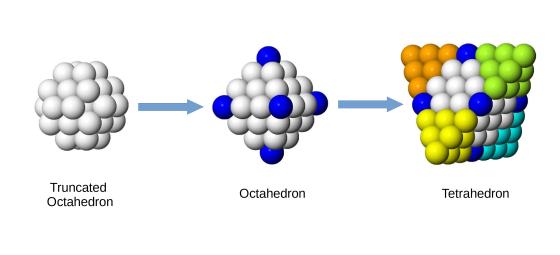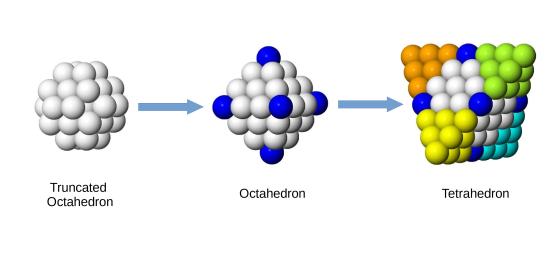The article has been selected by the Editors of Nature Communications as Highlight Paper
A joint experimental-theoretical work in collaboration between the Nanobiocomp group of Riccardo Ferrando at DIFI (https://sites.google.com/view/nanobiocomp) and research groups in Birmingham and York (UK) has now solved a long-standing open problem in crystal growth, that is the problem of the growth of tetrahedral nanocrystals. Their growth cannot be explained by existing theories such as the equilibrium or the kinetic Wulff construction.
The tetrahedron is the regular polyhedron with the highest surface/volume ratio. Tetrahedral nanoparticles can therefore be very interesting for applications to catalysis, in which a high surface/volume ratio is an advantage. But the tetrahedral shape is not energetically stable, so that nanoparticles of that shape are strongly out of equilibrium and are produced with much more difficulty than icosahedral, cubic or octahedral ones. In previous experiments, metallic tetrahedral nanoparticles were produced by wet chemistry methods in quite complex environments.

The experiments, performed in Birmingham by Yu Xia, Ziyou Li and in York by Jun Yuan, take the advantage of the very clean gas-phase physical synthesis methods to demonstrate that relatively small octahedra can grow to larger tetrahedra in a controlled way.
The molecular dynamics simulations, performed in Genoa by Diana Nelli and Riccardo Ferrando, shed light on the growth pathway. The pathway requires a specific symmetry breaking by which only four over eight facets of the octahedron grow to develop sharp tips. The simulation showed that the symmetry breaking is due to the generation of metastable defects.
Reference: Y. Xia, D. Nelli, R. Ferrando, J. Yuan & Z.Y. Li, Shape control of size-selected naked platinum nanocrystals, Nature Communications 12, 3019 (2021)


